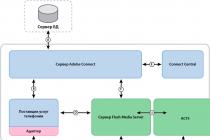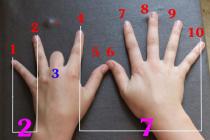Sony Xperia XZ Premium is perhaps the main novelty of the MWC, which the manufacturer focused on during his small press conference. This smartphone has received a number of advanced technologies that have not yet been available on the mobile device market. Whether all technical innovations are needed and whether they will be justified in the process of use is difficult to say. Nevertheless, we saw a truly breakthrough device, ready to compete in the premium segment, at least in terms of progressive hardware.
"Not like all strangers, but the same as your own." This is exactly what comes to mind when looking at the new Xperia XZ Premium, because its design is based on the updated concept of the Glass Loop Surface - the same shapes first introduced in the Xperia XZ, but now with the use of slightly different materials. The front and back surfaces are covered with a new generation of Gorilla Glass 5, while the frame itself is made of aluminum.


This, in our humble opinion, has a positive effect on the appearance and tactile sensations. But the large sides and not small dimensions caused a flurry of indignation among the inhabitants. The case is protected from dust and moisture according to the IP68 standard. There are two color options to choose from: Shiny Chrome and Deep Black.

In the captivity of iron, everything is much more interesting. I want to start with a 5.5-inch 4K HDR display with Ultra HD resolution (3840 × 2160 pixels at 801ppi). Unlike a similar matrix in the Xperia Z5 Premium, the new screen has been improved using some of the technologies used in BRAVIA TVs. The manufacturer notes the optimization of the screen for transmission of an even clearer, richer picture, improved noise reduction technology and HDR benefits to equalize contrast and exposure.

The next parameter, which was emphasized, is the main camera, or rather its hardware component. Here, Sony, as always, has enough innovations, the potential is huge, but whether it will be revealed is a different question.

In fact, we have a 1 / 2.3 ”19 Megapixel Exmor RS sensor with G Lens, f / 2.0 aperture with familiar technologies: predictive hybrid autofocus, laser focusing, infrared sensor and 5-axis digital stabilization Steady Shot. However, the camera module itself is dubbed "Motion Eye" with its own memory module and a fast intelligent image processor with motion detection. Thanks to this, the smartphone can shoot video at up to 960 frames per second - the best indicator among smartphones on the market.
No less sudden was the use of the latest Snapdragon 835 chipset in the Sony Xperia XZ Premium, which, according to rumors, was supposed to light up for the first time in the Galaxy S8. What can we say - the 8-core monster, made by 10nm technological process, demonstrates wild performance, is more optimized in terms of power consumption, and has a X16 gigabit modem.

The amount of RAM is 4 GB, the capacity of the internal high-speed UFS-drive is 64 GB, both in the version with one SIM-card and in the Xperia XZ Premium Dual SIM, there is the possibility of expanding the volume due to a microSD memory card. The capacity of the battery in dry numbers is not very impressive - 3230 mAh, although one of the decisive factors of autonomy is the optimization of the work of hardware and software. It's interesting to see the battery endurance tests. There is support for Quick Charge 3.0, Qnovo technology, Battery Care, energy-saving STAMINA technology. At the time of release, the smartphone runs on Android 7.1 Nougat.

The main specifications Sony Xperia XZ Premium:
- Physical dimensions: 156 x 77 x 7.9 mm, 195 grams
- Display technologies: 5.5-inch, 3840 x 2160 pixels, 801 ppi, 4K HDR, TRILUMINOS, X-Reality, 600 nits, Gorilla Glass 5
- Main camera: 19-megapixel 1 / 2.3 ”ExmorRS sensor, Motion Eye, f / 2.0 wide-angle lens, predictive hybrid autofocus, laser focus, infrared sensor, 5-axis Steady Shot stabilization, 4K video recording, video recording with a frequency of 960fps
- Front camera: 13-megapixel 1 / 3.06 "Exmor RS sensor, f / 2.0 aperture, autofocus.
- Chipset: Qualcomm Snapdragon 835 s 8 nuclear processor(4 x 45 GHz Kryo and 4 x 1.9 GHz Kryo) and Adreno 540 video chip
- RAM: 4 GB
- Internal memory: 64 GB UFS, microSD slot (cards up to 256 GB)
- Battery: built-in, 3230 mAh, fast charging Quick Charge 3.0, STAMINA
- Connections: A-GPS and GLONASS, Wi-Fi (802.11a / b / g / n / ac), Bluetooth 4.2, NFC, USB connector Type-C 3.1
- Network: GSM / GPRS / EDGE / UMTS / HSPA + / LTE cat9
- Audio: LDAC, DSEE HX, High-Resolution Audio, Clear Audio +, S-Force Front Surround
- Protection of the case against water and dust IP65 / 68
- Version for one and two SIM card nanoSIM format
- Fingerprint scanner in the power button
- Android 7.1 out of the box
Almost all the most interesting flagship smartphones of the first half of 2017 have already visited our laboratory: Xiaomi Mi6, LG G6, Samsung Galaxy S8 +. The turn came and.
advertising
Back in the spring, the company showed several new generation models at the exhibition: Sony Xperia XZs, Sony Xperia XA1, Sony Xperia XA1 Ultra and the recently announced state employee Sony Xperia L1. But a radically new smartphone with the latest SoC Qualcomm Snapdragon 835 was introduced under the name Sony Xperia XZ Premium and should replace the not very successful Sony Xperia Z5 Premium.

The novelty appeared at a very interesting time: trends are changing and now "frameless" smartphones, elongated displays and dual cameras are becoming popular. But then Sony comes out and promotes its values: strict "anti-slick" design, insane slow-mo and the same 4K screen.
But what is most interesting, despite such courage and an attempt to go against the tide, the smartphone was received very warmly. What is the matter here? Let's try to figure it out.
Specifications Sony Xperia XZ Premium
| Model | Sony Xperia XZ Premium | Sony Xperia Z5 Premium |
| Device type | Smartphone | Smartphone |
| CPU | Qualcomm Snapdragon 835 | Qualcomm Snapdragon 810 |
| Kernel configuration | 4 x 2.45 GHz + 4 x 1.90 GHz, Kryo 280 | 4 x 2.0 GHz + 4 x 1.5 GHz, Cortex-A57 + A53 |
| Video processor | Adreno 540 | Adreno 430 |
| Operating system | Android 7.0 | Android 5.1.1 (7.0) |
| RAM, GB | 4 | 3 |
| Internal memory, GB | 64 | 32 |
| Screen | 5.46 "IPS 4K, 3840 x 2160 | 5.5 "IPS 4K, 3840 x 2160 |
| Cameras, Mpix | 19.0 (f / 2.0) + 13.0 (f / 2.0) | 23.0 (f / 2.0) + 5.0 (f / 2.4) |
| Network | GSM 850/900/1800/1900 | GSM 850/900/1800/1900 |
| Number of SIM-cards, pcs. | 1/2 | 1/2 |
| MicroSD support | Yes (combined slot) | Yes (combined slot) |
| Data transfer | Wi-Fi, WAP, GPRS, EDGE, NFC, HSDPA, 3G, LTE | |
| aGPS / GPS / GLONASS / Beidou | Yes / Yes / Yes / Yes | Yes / Yes / Yes / Yes |
| Battery, mAh | 3 230 | 3 430 |
| Dimensions, mm | 156.0 x 77.0 x 7.9 | 154.4 x 75.8 x 7.8 |
| Weight, g | 195 | 180 |
| price, rub. | ~49 000 / ~55 000 | ~25 000 / ~33 000 |
An interesting fact is that the manufacturer gave the latest Snapdragon 835 not to the compact flagship in the form of the Sony Xperia XZs, but to the large version. This makes sense when you consider the high resolution of the screen, at which the additional power of the graphics accelerator can come in handy.
In relation to its predecessor, the novelty has become prettier in everything: one of the most unsuccessful SoCs (Snapdragon 810) has been replaced by a less hot solution, the front camera has finally acquired more or less high-aperture optics, and the volume of internal storage has doubled. But in some ways the smartphone is inferior to its brother. With a smaller screen diagonal, the device has become thicker, wider, longer and heavier. Despite this, the volume of the battery has decreased. Miracles, and nothing more. Plus, the installation of only 4 GB of RAM in 2017, when competitors are already offering 8 (!), Seems to be an extremely naive undertaking.
Sony Xperia XZ Premium packaging and arrangement

The smartphone comes in a traditional white box, decorated in the corporate style for the manufacturer.

On the reverse side, as usual, the technologies used are listed and some characteristics are indicated.

In the copies intended for retail, the delivery will include a memory unit, USB Type-C cable and documentation. In our case, only the power supply was missing from this list. It is a pity that it will not be possible to test the Qualcomm Quick Charge 3.0 fast charging system that the smartphone supports.
Last year, Sony surprised a lot: the company released, in fact, two flagships in one year. First within new series the Japanese showed the Xperia X Performance - it was the most powerful of the new smartphones, so it seemed that this is the flagship. However, a little later, the company made the Xperia XZ - a device with a similar filling, but a larger screen and a new design concept, which suddenly became the new leader of the family. Perhaps the company was unhappy with the sales, or maybe this was a cunning marketing move, the essence of which none of the townsfolk understood. Anyway, this year Sony is acting differently, updating the entire series at once.
The Xperia XZ Premium becomes the leader of the lineup, which is conceptually similar to the Xperia X5 Premium, and the successor to the previous flagship, the Xperia XZs, is becoming a more compact and affordable alternative. The Xperia XA1 and XA1 Ultra are in the first league this season. It seems that Sony is trying to build a unified lineup from different models of the past and think more about quality than quantity. Well, let's see how good the new Xperia flagship is and what it can put up with the market leader.
⇡ Specifications
| Sony Xperia XZ Premium | Sony Xperia Z5 Premium | Huawei P10 Plus | Samsung Galaxy S8 | HTC U Ultra | |
|---|---|---|---|---|---|
| Screen | 5.46 inches, IPS, 3840 × 2160 pixels, 807 ppi, capacitive multitouch | 5.5 inches, IPS, 2160 × 3840 pixels, 806 ppi, capacitive multitouch | 5.5 inches, IPS, 2560 × 1440 pixels, 540 ppi, capacitive multitouch | 5.8 inches, Super AMOLED, 1440 × 2960 pixels, 570 ppi, capacitive multitouch | 5.7 inches, IPS, 2560 × 1440 pixels, 513 ppi, capacitive multitouch + second display, 2.05 inches, 1040 × 160 |
| Safety glass | Corning Gorilla Glass 5 | There is no data | Corning Gorilla Glass 5 | Corning Gorilla Glass 5 | Corning Gorilla Glass 5 |
| CPU | Qualcomm Snapdragon 835 (MSM8998): eight cores (4 × 2.45 GHz + 4 × 1.9 GHz) | Qualcomm Snapdragon 810 (MSM8994): eight cores (4 × 1.5 GHz + 2 × 2.0 GHz Cortex-A57) | HiSilicon Kirin 960: eight cores (4 × 2.4 GHz ARM Cortex-A73 + 4 × 1.8 GHz ARM Cortex-A53) | Samsung Exynos 8895: eight cores (4 × M1, 2.5 GHz + 4 × Cortex-A53, 1.69 GHz) | Qualcomm Snapdragon 821 MSM8996 (two Kryo cores @ 2.35 GHz + two Kryo cores @ 1.36 GHz) |
| Graphics controller | Adreno 540, 710 MHz | Adreno 520, 600 MHz | ARM Mali-G71 MP8, 900 MHz | Mali-G71 MP20, 850 MHz | Adreno 530, 624 MHz |
| RAM | 4 GB | 3 GB | 4/6 GB | 4 GB | 4 GB |
| Flash memory | 64 GB | 32 GB | 64/128 GB | 64 GB | 64/128 GB |
| Connectors | 1 × USB Type-C | 1 × microUSB | 1 × USB Type-C | 1 × USB Type-C | 1 × USB Type-C |
| 1 × 3.5mm headset jack | 1 × 3.5mm headset jack | 1 × 3.5mm headset jack | |||
| 1 × nano-SIM; | 1 × nano-SIM; 1 × microSD |
1 × nano-SIM; 1 × microSD |
2 × nano-SIM | 1 × nano-SIM; 1 × microSD |
|
| 1 × microSD / 1 × nanoSIM / microSD | 1 × microSD | ||||
| Cellular 2G | GSM / GPRS / Edge 850/900/1800/1900 | GSM / GPRS / EDGE 850/900/1800/1900 MHz | GSM / GPRS / EDGE 850/900/1800/1900 MHz | GSM / GPRS / EDGE 850/900/1800/1900 MHz | |
| Cellular 3G | HSDPA 800/850/900 / 1700/1900/2100 |
HSDPA 800/850/900 / 1700/1900/2100 |
DC-HSPA 850/900 / 1900/2100 MHz |
1700/1900/2100 |
UMTS / HSPA + / DC-HSDPA 800/850/900 / 1700/1900/2100 |
| Cellular 4G | LTE Cat.16 (1024 Mbps, 150 Mbps), ranges 1, 2, 3, 4, 5, 7, 8, 12, 13, 17, 19, 20, 26, 28, 29, 32, 38 , 39, 40, 41 | LTE Cat. 4 (150 Mbps, 50 Mbps), ranges 1, 2, 3, 4, 5, 7, 8, 12, 13, 17, 19, 20, 26, 28, 29, 32, 38, 39, 40, 41 | LTE Cat. 4 (150 Mbps, 50 Mbps), ranges 1, 2, 3, 4, 5, 7, 8, 18, 19, 26, 28, 38, 40, 41 | LTE Cat.16 (1024 Mbps, 150 Mbps), ranges 1, 2, 3, 4, 5, 7, 8, 17, 20, 28 | LTE Cat.11 (up to 600 Mbps): bands 1, 2, 3, 4, 5, 7, 8, 12, 17, 20, 28, 38, 39, 40, 41 |
| Wi-Fi | 802.11 a / b / g / n / ac 2.4 / 5 GHz | 802.11 a / b / g / n / ac 2.4 / 5 GHz | 802.11 a / b / g / n / ac 2.4 / 5 GHz | 802.11 a / b / g / n / ac 2.4 / 5 GHz | 802.11 a / b / g / n / ac 2.4 / 5 GHz |
| Bluetooth | 5.0 | 4.1 | 4.2 | 5.0 | 4.2 |
| NFC | There is | There is | There is | There is | There is |
| Navigation | GPS, A-GPS, GLONASS, Galileo | GPS, A-GPS, GLONASS | GPS, A-GPS, GLONASS | GPS, A-GPS, GLONASS, BeiDou, Galileo | GPS, A-GPS, GLONASS, BeiDou |
| Sensors | Illumination, approximation, accelerometer / gyroscope, magnetometer (digital compass) |
Illumination, proximity, accelerometer / gyroscope, magnetometer (digital compass) | Illumination, proximity, accelerometer / gyroscope, magnetometer (digital compass), Hall sensor | Illumination, proximity, accelerometer / gyroscope, magnetometer (digital compass), Sensor Hub | |
| The fingerprint scanner | There is | There is | There is | There is | There is |
| Main camera | 19 MP, ƒ / 2.0, laser + phase contrast autofocus, LED flash, 4K video recording, HD video recording at 960 fps | 23 MP, ƒ / 2.0, laser + phase contrast autofocus, LED flash, 4K video recording |
2 × 12 MP, ƒ / 1.8, laser autofocus, LED flash, 4K video recording | 12 MP, ƒ / 1.7, phase detection autofocus, optical stabilization, LED flash | 12 MP, ƒ / 1.8, hybrid autofocus (contrast with laser backlight + phase), optical stabilization, LED flash, 4K video recording |
| Front-camera | 13 MP, ƒ / 2.0, contrast autofocus, video recording in Full HD | 5.1 MP, ƒ / 2.4, contrast autofocus, Full HD video recording |
8 MP, contrast autofocus, no flash | 8 MP, ƒ / 1.7, autofocus, no separate flash | 16 MP, fixed autofocus |
| Nutrition | Removable battery: 12.2 Wh (3230 mAh, 3.8 V) | Removable battery: 13 Wh (3430 mAh, 3.8 V) | Removable battery: 14.25 Wh (3750 mAh, 3.8 V) | Removable battery: 11.4 Wh (3000 mAh, 3.8 V) | |
| The size | 156 x 77 x 7.9 mm | 154.1 x 75.8 x 7.8 mm | 153.5 x 74.2 x 7 mm | 148.9 x 68.1 x 8 mm | 162.4 x 79.8 x 8mm |
| Weight | 191 g | 180 g | 165 g | 155 g | 170 g |
| Water and dust resistant | Yes, IP68 standard | Yes, IP68 standard | No | Yes, IP68 standard | No |
| Operating system | Android 7.1 Nougat | Android 5.0 Lollipop (Android 7.0 Nougat supported) | Android 7.0 Nougat, shell EMUI 5.1 | Android 7.0 Nougat, Grace UX wrapper | Android 7.0 Nougat, HTC Sense's own skin |
| Actual price | 54,990 rubles | 45,990 rubles | 44,990 rubles | 59,990 rubles | 49,000 rubles |
|
|
|
|
⇡ Design, ergonomics and software
At first glance, nothing special for Sony and nothing new. The current flagship is made in the usual Sony style and is similar to the Xperia XZ, increased in size - the same sharp edges, the same large space at the top and bottom. The ratio of the screen area to the total front surface is not at all impressive - only 68: 100. Compare this with the Samsung Galaxy S8 and its 83: 100. However, it should not be noted that the side frames remain quite thin, but safety glass slightly goes to the side edges, which affects the visual perception of the smartphone.

As befits a flagship in 2017, the Xperia XZ Premium is made of glass and metal. The front and back panels are completely covered with Gorilla Glass 5. It is curious that in the silver version of the smartphone the back panel is mirrored, you can look into it, and the girls really like it. Apart from the silver variant, the Xperia XZ Premium is available in black and pink. True, the latter option has not yet begun to be sold in Russia.

The side edges are very smooth, rounded, the smartphone is comfortable to hold in the hand, despite its impressive size - I had about the same sensations when working with the iPhone 7 Plus. But straight lines at the top and bottom can be uncomfortable for those who are used to carrying a smartphone in the front pocket of jeans. Here Sony is repeating the mistakes made by the rectangular Lumia designers on Windows Phone.
|
|
|
The location of the main elements on the body has not changed. Above is a 3.5 mm audio jack. It's nice that Sony isn't following the dubious trend that Apple and HTC have picked up, or forcing you to switch to wireless headphones or USB-C models.

At the bottom is the USB Type-C that has become the new standard, and on the right edge are the volume keys, the power button (with a built-in fingerprint scanner) and start the camera. On the left side there is a compartment for SIM-cards and a microSD flash drive. The traditional "trouble" of Sony smartphones is that every time you remove this tray, the device automatically goes into reboot, while there are no technical restrictions for hot swapping a SIM card and microSD drive for a long time.
|
|
|
In terms of dimensions, the Xperia XZ Premium cannot surprise: the thickness of 7.9 millimeters has not been impressive for a long time, and the width of 77 mm allows you to somehow work with the smartphone with one hand - you can enter text without problems, but it is not easy to reach the top edge. And of course, I must say that the smartphone is too heavy - it weighs 191 grams. It's even slightly heavier than the iPhone 7 Plus, which seems overweight today. In addition, I have big concerns about reliability - a heavy smartphone is easier to break. The owners of the Xperia Z5 Premium actively complained about the fragility, because even a fall from a height of 60-70 centimeters led to cracks on the back or on the screen. In general, I did not test the strength of the XZ Premium, but I advise you to use it very carefully.

But the good news is that the dust and moisture protection is still there. Sony Xperia XZ Premium meets the IP68 standard and can withstand half an hour underwater at a depth of one and a half meters. And the presence of a dedicated key for shooting makes it suitable for underwater photography. True, the manufacturer emphasizes that this is just an ordinary protected smartphone, and not a full-fledged underwater device.
|
|
|
Returning to the dedicated button for the camera, it should be noted that there is a quick launch option: you can point your smartphone with the screen off and press the camera key - the picture will be taken. In some situations, the second saved can play a decisive role, so the function will definitely be useful.
Although Sony's Xperia XZ Premium ticks almost every field on the High-End Smartphone Test Checklist, and offers Android 7.1 users with excellent performance, it does not make it to the Top -5 "of our respective rating. In particular, the quality of low-light photos is poor. And also because Sony, even in its flagship smartphone, refuses a device for fast charging, the scores in the "Battery" test category are lower than those of direct competitors.
Advantages
very fast processor
excellent equipment
high quality workmanship
disadvantages
the mirror surface of the case collects a lot of fingerprints
the camera in low light does not correspond to the high-end-level
- Price-quality ratio
Good - Place in the overall rating
17 of 200
- Value for money: 73
- Performance & Management (35%): 93.2
- Equipment (25%): 93.8
- Battery (15%): 80
- Display (15%): 89.7
- Camera (10%): 73.4
Editorial grade
User rating
You have already rated
Sony Xperia XZ Premium is a mirror
For several years, Sony has not fundamentally changed anything in the design of its smartphones, so this time it continues to rely on the minimalist look that we know from the devices Xperia series... In principle, it all looks good and elegant, but in the case of the Xperia XZ Premium, it is already hitting its limits.
Firstly, the phone turns out to be very large, since the screen is surrounded on all sides by clearly defined frames. In addition, at the bottom of the Sony company has placed an additional black bar with soft control buttons, which also occupies a certain place.
On the other hand, in the silver / chrome case of the device we tested, everything is reflected as in a mirror. Within a short time, both the front and back surfaces were covered with numerous fingerprints and greasy spots. Of course, they can be erased on clothes, but you definitely won't be able to recognize them as beautiful. But now there are no problems with taking a selfie with the main camera. The edges here are also glossy, rounded and very smooth, which leads to easier slipping from the fingers of the device weighing 190 grams during a telephone conversation.
Mirror surface: Xperia XZ Premium lets you take selfies with the main camera
Superb 4K display
In terms of equipment, Sony is rolling out several pieces of heavy artillery into position at once. These include an extremely clear 5.5-inch 4K display. Xperia XZ Premium in UHD resolution presents not only photos and videos, but also display user interface.
However, in everyday life, a picture with a pixel density of 800 ppi is unlikely to provide any advantages over 400 ppi. Even if we bring the smartphone very close to our eyes, we will most likely not be able to notice the difference in clarity. However, VR fans ( virtual reality) will be able to derive some benefit from this.
Like competitors LG and Samsung, Sony advertises support for HDR technology(High Dynamic Range). The screen boasts really wide color gamut coverage and superb picture quality, but it doesn't shine as brightly as a Full HD display. The latter achieves a remarkable 582 cd / m2, while Sony can offer only 485 cd / m2 for XZ Premium users. However, in most cases, the content reads reasonably well.
 The display shows content in 4K resolution - but it's almost impossible to understand
The display shows content in 4K resolution - but it's almost impossible to understand Battery: the wrong thing to save Sony
Of course, the UHD resolution on the large display took some tribute during our online testing. Here the Xperia XZ Premium, although it managed to hold on for a good eight and a half hours, is still far from nearly ten hours of the cheaper Xperia XZs.
The device missed a certain number of rating points, not least due to the duration of the charging process, which lasts more than three hours. And although the XZ Premium itself supports Quickcharge 3.0 fast charging technology, Sony decided to save a little and put in the package a regular power supply with a capacity of only 7.5 watts.
 A freshly polished phone looks gorgeous, but its surface gets covered with fingerprints very quickly.
A freshly polished phone looks gorgeous, but its surface gets covered with fingerprints very quickly. The Xperia XZ Premium camera with advantages and disadvantages
Sony has paid great attention to the digital camera of its new flagship and equipped it with a high resolution of 19 megapixels, as well as a high-speed video function with 960 frames per second. Essentially the camera is similar to that of the Xperia XZs, but in our tests it performed slightly better. The reason most likely could be a new version firmware.
The quality of the photos here can be considered good for the most part, but in comparison with such direct competitors as, above all, the Xperia XZ Premium still reveals certain drawbacks. Pictures taken in low light do not correspond to the high-end-level of the device. This is clearly shown by comparing the photos taken by the smartphone we tested and the HTC U11.
However, even in daylight, the Sony camera falls short of competing competitors. Outlines are often noticeably fuzzy and surfaces are blurry. Most likely, the matter is that the matrix is too small for the high resolution used.
 Twilight shots: Compared to the HTC U11, the Xperia XZ Premium has less detail and more artifacts. In addition, they are somewhat darkish.
Twilight shots: Compared to the HTC U11, the Xperia XZ Premium has less detail and more artifacts. In addition, they are somewhat darkish. High speed camcorder
The camcorder mode called "High Frame" is interesting function that will give you a lot of fun shooting in daylight. In this mode, the camera records videos in HD resolution at speeds up to 960 frames per second, so you can then very slow down the playback of footage.
However, because the shutter speed per frame is extremely fast in this mode, indoor results often appear too dark and too noisy. It is practical to be able to take “proactive” shots. In this mode, the camera takes photos even before pressing the shutter button, so that you can then choose a better shot - this mode is especially useful when shooting moving objects.
 The Sony Xperia XZ Premium camera has several good features
The Sony Xperia XZ Premium camera has several good features Top performance
In terms of performance, the Xperia XZ Premium is on par with the best models on the market (and in our ranking of smartphones). The Snapdragon 835 delivers snappy UI, smooth scrolling, nice responsiveness and fast app launches. This "system on a chip" also contains Gigabit LTE and Bluetooth 5 modules.
Whoever needs 64 GB of internal memory can expand it using microSD cards. The data exchange with the computer will be pleasantly fast too thanks to the presence of USB 3.1 Type-C. Last but not least, the protection of the case in accordance with the IP-68 standard is practical, which means for users the ability to drop the smartphone into the water without consequences.
Sony sells the Xperia XZ Premium in chrome and black for an initial cost of RUB 54,990.
 Waterproof: Sony Xperia XZ Premium users need to worry about rain or falling into water
Waterproof: Sony Xperia XZ Premium users need to worry about rain or falling into water Alternative: Sony Xperia XZ
Cheaper, not as well equipped, but with a longer time autonomous work: Sony fans can't go wrong with their choice. At the same time, a smartphone, which has been sold since last autumn, costs about 13,000 rubles less. In some online stores it can be found even cheaper than 40,000 rubles.
Sony Xperia XZ Premium test results


















Sony Xperia XZ Premium specifications and test results
| Price-quality ratio | 73 |
| OS when testing | Android 7.1 |
| Current OS | Android 8 |
| Is there an OS update planned | there is no data |
| App Store | |
| The weight | 189 BC |
| Length x Width | 156 x 78 mm; |
| Thickness | 8.0 mm; |
| Expert design assessment | very good |
| Expert assessment of the speed of work | very good |
| Download speed: PDF 800 KB over WLAN | 2.3 s |
| Download speed: main chip.de over WLAN | 0.5 s |
| Download speed: chip.de test chart over WLAN | 5.2 s |
| Sound quality (speakerphone) | very good |
| CPU | Qualcomm Snapdragon 835 |
| Processor architecture | |
| CPU frequency | 2.450 MHz |
| Number of CPU cores | 4+4 |
| RAM size | 4.0 GB |
| Battery: capacity | 3.230 mAh |
| Battery: easy to remove | - |
| Battery: surfing time | 8:26 h: min |
| Battery: charging time | 3:03 h: min |
| Fast charging function | Yes |
| Charger and fast charging cable included | |
| Battery: discharge time / charge time | 2,8 |
| Wireless charging function | - |
| WLAN | 802.11 n, ac |
| Voice over LTE | |
| LTE: frequencies | 800, 1.800, 2.600 MHz |
| LTE: Cat. 4 | up to 150 Mbps |
| LTE: Cat. 6 | up to 300 Mbps |
| LTE: Cat. nine | up to 450 Mbps |
| LTE: Cat. 12 | up to 600 Mbps |
| Screen: type | LCD |
| Screen: diagonal | 5.5 inch |
| Screen: size in mm | 68 x 122 mm; |
| Screen: Resolution | 3.840 x 2.160 pixels |
| Screen: Dot Density | 801 ppi |
| Screen: max. brightness in a dark room | 485.9 cd / m² |
| Screen: checkerboard contrast in a bright room | 32:1 |
| Screen: checkerboard contrast in a dark room | 131:1 |
| Camera: Resolution | 19.2 megapixels |
| Camera: measured resolution | 1.815 line pairs |
| Camera: expert assessment of image quality | OK |
| Camera: Noise VN1 | 1.9 VN1 |
| Camera: minimum focal length | 4.4 mm; |
| Camera: minimum shooting distance | 9 cm; |
| Camera: autofocus shutter release time | 0.76 s |
| Camera: optical stabilizer | - |
| Camera: autofocus | Yes |
| Camera: Flash | LED |
| Video resolution | 3.840 x 2.160 pixels |
| Front camera: resolution | 13.0 megapixels |
| LED indicator | yes (multicolor) |
| Radio | - |
| SIM card type | Nano-SIM |
| Dual SIM | - |
| Dust and moisture proof (IP certified) | IP68 |
| The fingerprint scanner | |
| User available memory | 49.3 GB |
| Memory card slot | Yes |
| USB connector | Type-C-USB 3.1 |
| Bluetooth | 5 |
| NFC | Yes |
| Headphone out | 3.5 mm; |
| HD Voice | Yes |
| SAR | 1.21 W / kg |
| Firmware version during testing | 45.0.A.1.229 |
| Test date | 2016-05-22 |
World's first 4K HDR smartphone with 960fps slow motion
Last spring in Barcelona, the international GSM association announced at the annual Global Mobile Awards (Glomo Awards) that the new Sony flagship The Xperia XZ Premium won Best in the New Smartphones and Mobile Devices category at MWC 2017. And this is not the only award received by the favored press and critics for the Sony Xperia XZ Premium during the exhibition. In this regard, President and CEO of Sony Mobile Communications, Hiroki Totoki, said: “The Xperia XZ Premium is the most technically advanced smartphone we've ever made.” At the very least, the Xperia XZ Premium is the world's first smartphone with a 4K HDR display (5.5 ″), as well as a new Motion Eye camera capable of recording videos at 960 frames per second and playing them back in slow motion. four times slower than other smartphones. Finally, the new Japanese flagship arrived in Russia and became available in official retail.
Key Features Sony Xperia XZ Premium (G8142)
- SoC Qualcomm Snapdragon 835 (MSM8998), 4 Kryo cores @ 1.9 / 2.4 GHz
- GPU Adreno 540
- Operating system Android 7.1.1
- 5.5 ″ IPS touchscreen display, 3840 × 2160, 801 ppi
- Random access memory (RAM) 4 GB, internal memory 64 GB
- Nano-SIM support (2 pcs.)
- MicroSD support up to 256GB
- GSM / GPRS / EDGE networks (850/900/1800/1900 MHz)
- WCDMA / HSPA + networks (850/900/1700/1900/2100 MHz)
- FDD LTE Cat.16 networks
- Wi-Fi 802.11a / b / g / n / ac (2.4 and 5 GHz) MIMO
- Bluetooth 5.0
- GPS, A-GPS, Glonass, BDS
- USB 3.1 Type-C, USB OTG
- Main camera 19 MP, autofocus, f / 2.0, 4K video
- Front camera 13 MP, f / 2.0
- Proximity, lighting, pressure sensors, magnetic field, accelerometer, gyroscope, step counter
- Super slow motion video at 960 fps
- Dust and moisture protection IPS65 / 68
- Battery 3230 mAh
- Dimensions 156 x 77 x 7.9mm
- Weight 191 g
Appearance and usability
Sony Mobile remains true to tradition, this applies to both the appearance of its smartphones and the software shell. The design of the novelty uses the same familiar Loop Surface principle: the metal frame, bending, with its curved edges goes to all panels - front, back and side. The frame itself is made of polished metal to a mirror-like luster, it is echoed by two glass panels of Gorilla Glass 5. As a result, we have one of the most slippery and easily soiled smartphones, in this only Xiaomi Mi Mix can be compared with it.

At the same time, the design and decoration are really impressive: the case with a mirror-like shine with sharp corners and flat end panels looks at least impressive, and maybe even status. Another thing is that all this splendor runs counter to ergonomics and comfort: sharp corners take up a lot of extra space in your pocket and dig into your hips, and shiny surfaces, of course, are instantly covered with fingerprints.

This is not to say that glass panels themselves are very slippery, but no one usually holds a smartphone for them. But the polished and varnished sides of the convex metal frame are extremely slippery, so it is rather difficult to lift the smartphone from the table.
 |
 |
As for materials and build quality, here, of course, there can be no complaints, Sony is always in full order with this. But about the dimensions it is worth saying a few words. The Sony Xperia XZ Premium has a 5.5-inch screen, which is not that big by today's standards, but in terms of body size it is comparable to the Samsung Galaxy S8 + with a significantly larger screen (6.2 ″).

The bezels around the screen look too wide, especially the top and bottom segments, which are 17 mm high, and there are not even touch buttons at the bottom. A lot of space is empty, and the only explanation for such indents is stereo speakers placed at the top and bottom in the frontal plane.

The glass of the panel has barely noticeable curvatures at the transition to the end faces, but only on the sides. There is an LED event indicator above the screen.

The back panel here is also a real glass, it is not plastic, but the same Gorilla Glass 5 as the front. The camera module is single, not double. The camera does not protrude beyond the surface, the back panel is absolutely flat.

All hardware buttons are located on the right side. The one that is responsible for power and lock, has a built-in fingerprint scanner, it is easy to touch it, it is convenient to use. The other button responsible for volume control, on the contrary, is quite smooth, slippery, shallow, sticking out a little outside the body. It is difficult to find it blindly. There is a third, very small and barely noticeable, it is traditionally for Sony responsible for working with the camera.

The card slot is hybrid here: you can install two Nano-SIM cards or replace one of them with a memory card. Sony usually makes two variants of each model - single and dual SIM, and the Xperia XZ Premium is no exception. Only here are not one, but two pull-out trays, and they are covered with a convenient lid that does not need to be squeezed out with a paper clip. All Sony smartphones automatically reboot as soon as the card sled is removed from the case, regardless of whether there are any cards at all.

The smartphone is IP65 / IP68 waterproof. The standard assumes that the device can spend up to half an hour under water, but Sony prohibits this, mentioning only protection from splashing rain or from an accidentally spilled glass.

At the top there is an audio output for headphones (3.5 mm), as well as an auxiliary microphone.

The bottom end is for the main conversational microphone and a universal USB Type-C connector that supports connection to USB mode OTG.

The Sony Xperia XZ Premium is available in three color options: Luminous Chrome, Deepsea Black and Bronze Pink. We tested the "regular" black version, but apparently, Sony is betting on the pink bronze. Designer Satoshi Aoyagi particularly commented on this: “We wanted to find a shade that would create a sense of warmth and at the same time exemplify premium design and functionality. Bronze metallic overflow adds depth to the color of the front and back of the smartphone, while diamond cut technology adds extra shine to the top and bottom bezels. "

Screen
The Sony Xperia XZ Premium features an IPS display with 2.5D Corning Gorilla Glass 5. Uses Triluminos, X-Reality for mobile and Dynamic Contrast Enhancer. The dimensions of the screen are 68 × 121 mm with a diagonal of 5.5 inches. The resolution is 3840 × 2160, the density of the pixels is very high here, about 801 ppi. It is the world's first smartphone with a 4K HDR display.
The frame around the screen is wide by modern standards, more than 4 mm on the sides and 17 mm at the top and bottom. Together with the sharp corners of the case itself, it all looks quite cumbersome.
The brightness of the display can be manually adjusted or automatic settings based on the operation of the ambient light sensor. The AnTuTu test diagnoses support for 10 simultaneous multitouch touches. The screen supports work with gloves.
 |
 |
A detailed examination using measuring instruments was carried out by the editor of the "Monitors" and "Projectors and TV" sections Alexey Kudryavtsev... Here is his expert opinion on the screen of the test sample.
The front surface of the screen is made in the form of a glass plate with a mirror-smooth surface, resistant to scratches. Judging by the reflection of objects, the anti-glare properties of the screen are slightly better than that of the Google Nexus 7 (2013) (hereinafter simply Nexus 7). For clarity, here is a photo in which a white surface is reflected in the turned off screens of both devices (Sony Xperia XZ Premium, as it is easy to determine, is on the right, then they can be distinguished by their size):

Both screens are dark, but the Sony screen is slightly darker (its brightness in the photo is 107 versus 117 for the Nexus 7). The tripling of reflected objects in the Sony Xperia XZ Premium screen is very weak, which indicates that there is no air gap between the outer glass (aka touch sensor) and the matrix surface (OGS type screen - One Glass Solution). Due to the smaller number of boundaries (such as glass / air) with very different refractive indices, such screens look better in conditions of intense ambient light, but their repair in the case of cracked outer glass is much more expensive, since the entire screen has to be changed. On the outer surface of the screen there is a special oleophobic (grease-repellent) coating (very effective, even better than that of the Nexus 7), so fingerprints are much easier to remove, and appear at a slower rate than in the case of ordinary glass.
With manual brightness control and with the display of the white field in full screen, its maximum value was about 460 cd / m², and the minimum - 4.7 cd / m². The maximum value is high and, given the excellent anti-glare properties, readability even on a sunny day outdoors should be at an acceptable level. In complete darkness, the brightness can be lowered to a comfortable level. Automatic brightness control works according to the light sensor (it is located to the right of the slot of the front speaker). In automatic mode, when the ambient light conditions change, the screen brightness both increases and decreases. The operation of this function depends on the position of the brightness control, with it the user can try to set the required brightness level in the current conditions. We slightly increased the brightness in complete darkness and found that in complete darkness the auto-brightness function reduces the brightness to 12 cd / m2, in an office illuminated with artificial light (about 550 lux) it sets to 190 cd / m2, in a very bright environment (corresponds to clear lighting outdoors during the day, but without direct sunlight - 20,000 lux or slightly more) increases to 460 cd / m². The result was quite satisfactory for us. It turns out that the automatic brightness control function works adequately and to some extent allows the user to customize his work for individual requirements. Only at a very low brightness level there is a significant modulation of the backlight, but its frequency is high, about 2.3 kHz, so even in this case there is no visible screen flicker.
This screen uses an IPS type matrix. The micrographs show the typical IPS subpixel structure:

For comparison, you can see the gallery of photomicrographs of screens used in mobile technology.
However, the subpixels themselves are arranged unconventionally: typical columns go in the horizontal direction, but in each of the columns the triads of subpixels are shifted by one subpixel vertically, first upwards, and three columns downwards. Note that we have already seen a similar arrangement of subpixels in the case of the Sony Xperia Z5 Premium. As a result, the ratio of columns horizontally to triads vertically is 3 to 2, the actual vertical resolution is 1/3 less than the horizontal one (hereinafter we mean the landscape orientation of the screen). That is, the points (RGB triads) on the screen are actually only 3840 × 1440, and not 3840 × 2160.
Additional tests have shown that not every application is capable of displaying images at this conventional 4K resolution. For example, all tested third party applications believe that the screen has a Full HD resolution, that is, 1920 by 1080 pixels, and the image is displayed in this resolution, and the smartphone itself scales the picture to the true screen resolution. Sony's own image demonstrator only (app Album) displays a picture in 4K resolution. The second exception is video output using hardware decoding. Let us consider the features of such an output using the example of a vertical and horizontal planes with black stripes one pixel thick through a white gap also one pixel. The original test image is available at this link, the world is in the center. Here is a snippet of it:

With vertical (on the left) stripes, everything is fine: clear, pixel by pixel. With the horizontal ones (on the right side), everything is worse, since the dark gaps are only one subpixel thick and visually the world is seen simply as a gray field. In addition, at the bottom and at the top of the horizontal target, instead of stripes, some kind of mess is displayed - apparently, this is an error in the conversion to the resolution of a strange matrix. However, formally black and white resolution of 3840 × 2160 pixels is still implemented.
The screen has good viewing angles without inverting tints and without significant color shift, even with large gaze deviations from the perpendicular to the screen. For comparison, here is a photo in which the screens of Nexus 7 and Sony Xperia XZ Premium display the same images, while the brightness of the screens was initially set to about 200 cd / m² (across the white field across the entire screen), and the color balance on the camera was forcibly switched to 6500 TO.
White field perpendicular to the plane of the screens:

Note the good uniformity of brightness and color tone of the white field.
And the test picture:

The colors on the Sony Xperia XZ Premium display are oversaturated, skin tones are reddish, and the color balance is noticeably different from standard. Also, as shown by additional tests, the color contrast is slightly increased.
Now at an angle of approximately 45 degrees to the plane and to the side of the screen:

It can be seen that the colors have not changed much for both screens, the contrast has remained at a good level.
And a white box:

The brightness at an angle on both screens has noticeably decreased (at least 5 times, based on the difference in shutter speed), but in the case of the Sony Xperia XZ Premium, the brightness drop is slightly less (the brightness in the photos is 232 versus 226 for the Nexus 7). The black field, when deviated along the diagonal, does not lighten very much and acquires a purple tint. The photos below demonstrate this (the brightness of the white areas in the direction perpendicular to the plane of the screens is the same for the screens!):

And from a different angle:

The Nexus 7's black field at the corners is still slightly darker. When viewed from a perpendicular view, the uniformity of the black field is excellent:

The contrast (approximately in the center of the screen) is high - about 960: 1. The response time for the transition black-white-black is 24 ms (11 ms on + 13 ms off). The transition between gray tones of 25% and 75% (based on the numerical value of the color) and back takes 34 ms in total. The gamma curve, plotted at 32 points with equal intervals by the numerical value of the shade of gray, did not reveal a blockage in either highlights or shadows, and the exponent of the approximating power function was 2.31, which is slightly higher than the standard value of 2.2. In this case, the real gamma curve deviates little from the power dependence:

We did not reveal the presence of dynamic adjustment of the backlight brightness in accordance with the nature of the displayed image, which is very good.
By default, the color gamut is noticeably wider than sRGB:

If the image on the screen of this smartphone still seems to someone to be insufficiently "bright" and "colorful", then in the screen settings you can enable Extreme brightness mode.

The result is shown below:

Saturation and color contrast are enhanced even further. The color gamut in this mode almost completely covers the Adobe RGB gamut.

We look at the spectra:

They are typical of Sony's top-end mobile devices. Apparently, this screen uses LEDs with a blue emitter and a green and red phosphor (usually a blue emitter and a yellow phosphor), which, in combination with special matrix light filters, allows obtaining a wide color gamut. Yes, and in the red phosphor, apparently, the so-called quantum dots are used. Unfortunately, as a result, the colors of images - drawings, photographs and films - oriented to the sRGB space (and there are the overwhelming majority of them) have an unnatural saturation. This is especially noticeable on recognizable shades, such as skin tones. The result is shown in the photos above.
However, not everything is so bad, in the mode Professional coverage is adjusted to sRGB borders:

We look at the spectra:

It can be seen that in this mode the color components are mixed with each other, which makes it possible to reduce the color gamut. Let's look at the test image in this mode:

So much better! Hence the advice: having a smartphone at your disposal, be sure to select the mode Professional, only in this mode can you view photos and watch movies obtained from most sources available to a common user.
By default, the balance of shades on the gray scale is slightly compromise, since the color temperature is higher than the standard 6500 K, and the deviation from the spectrum of the absolute black body (ΔE), although not very large, changes noticeably from shade to shade. But at least the color temperature variation is small. (The dark areas of the gray scale can be ignored, since the color balance there is not very important, and the error in measuring the color characteristics at low brightness is large.)


This smartphone has the ability to correct the color balance by adjusting the intensities of the three primary colors.

Which is what we tried to do; the result is data signed as Corr. in the graphs above. As a result, we corrected the color temperature and, at least in the light area, reduced ΔE. This is a good result, but the brightness (as well as the contrast) has dropped from 460 to 415 cd / m².
Let's summarize. The brightness adjustment range of this screen is wide, the anti-glare properties are excellent, which allows you to comfortably use your smartphone both on a sunny day outside and in complete darkness. It is permissible to use the mode with automatic brightness adjustment, which works adequately. The advantages also include a very effective oleophobic coating, no air gap in the layers of the screen and no flicker, moderate black lightening when looking away from the perpendicular to the screen surface, excellent uniformity of the black field. By default, the color balance is not the best, but the presence of appropriate adjustments allows you to correct it to an acceptable level, albeit at the expense of a slight decrease in brightness (and contrast). Taking into account the importance of characteristics for this particular class of devices (and the most important thing is the distinguishability of information in a wide range of external conditions), the screen quality can be considered very high. Compared with the Sony Xperia Z5 Premium, we can conclude that Sony has done an effective job of correcting errors, the new smartphone finally has a high-quality sRGB mode and eradicated dynamic brightness adjustment depending on the nature of the displayed image. We have been waiting for this since 2014, when the Sony Xperia Z2 appeared on the market. Better late than never!
Cameras
The front module has an Exmor RS sensor with an area of 1 / 3.06 "and a resolution of 13 megapixels, as well as a 22mm wide-angle lens with an f / 2.0 aperture without its own flash and autofocus. The maximum sensitivity of the matrix is ISO 6400, there is the same five-axis SteadyShot stabilization with smart mode Intelligent Active Mode, just like the main camera. The shooting quality is generally good: the image is bright, sharp and detailed. However, as can be seen from the examples, the matrix still fails to organically expose both dark and light areas at the same time, the sky is completely lightened even in even daylight.
For the main camera, Sony has saved a new exclusive module that other manufacturers will not get yet. It uses a 1 / 2.3 ″ mobile Exmor RS sensor with 1.22 µm pixels. The 25mm wide-angle G Lens has an f / 2.0 aperture. The maximum light sensitivity of the matrix is ISO 12800, but you can manually set only ISO 3200. The main feature of the new Motion Eye camera is its own fast memory, which made it possible to shoot Super slow motion video at 960 fps. True, there are noticeable limitations. Firstly, super slow mode is available only in 720p resolution, and the picture quality in it, of course, leaves much to be desired. Secondly, it is impossible to simply start shooting video in this mode, it can only be activated for a few seconds during normal shooting, and the result will be presented in the form of frames in a standard video. That is, you either have to delicately seize the moment, which is sometimes not easy, or you just have to cut pieces of slo-mo into a longer scene. It is impossible to manually select areas after shooting on the resulting video, what happened is what happened.
The rest of the camera's capabilities are familiar to us: there is a predictive hybrid autofocus and a proprietary five-axis stabilization SteadyShot with two modes, the most "smart" of which (Intelligent Active Mode) is better not to use - everything "floats", the shape of objects in the frame is noticeably distorted. Standard SteadyShot works much better.
Manual settings, as usual, allow you to set the shutter speed, sensitivity, exposure compensation, white balance, and select the focusing option. However, if you use the side button, the camera always turns on in auto mode. But in automatic mode, she knows how to take several frames even before the user presses the shutter button (Predictive Capture).
 |
 |
 |
 |
 |
 |
The camera can shoot video in maximum 4K resolution, but this mode is selected in the menu separately. There is also a shooting mode at 60 fps, normal Full HD @ 30 fps, as well as the aforementioned slow motion. Unlike Huawei smartphones, the H.264 codec is used here for both 4K video and 60 fps, not H.265. The camera copes well with video shooting. Focusing does not fail, there are no jerks, no artifacts, the image is bright and detailed. Sound recording is made at a decent level, the noise reduction system also copes with its tasks.
- Movie # 1 (111 MB, 3840 × [email protected] fps, H.264, AAC)
- Movie # 2 (34 MB, 1920 × [email protected] fps, H.264, AAC)
- Movie # 3 (40 MB, 1920 × [email protected] fps, H.264, AAC)
 |
Quite good sharpness across the frame. |
 |
Good detail in the middle of the frame, but large areas of blur are noticeable on the sides. |
 |
The camera copes well with macro photography. |
 |
The text has been worked out well. |
 |
Quite good detail in the distant shots. There are still many areas of confusion. |
 |
The detail is good only in the middle of the frame. |
We also tested the camera on a laboratory bench using our method.


The camera turned out to be quite good, but this time I can't call it flagship. Some strange software processing inherent more to the middle segment of cameras immediately catches the eye. There are huge areas of blur that are completely unjustified. We, of course, know that Sony has a habit of refining cameras by the time of the start of sales, but for now it is difficult to argue that these zones will disappear. In the center of the frame, the detailing is at a very good level, but in its current form the camera can only be recommended for documentary shooting.
The laboratory bench confirms a good resolution in the center of the frame, but only in good lighting conditions. However, the edge of the frame is not too bad either. But the flash of the camera is very weak. Hopefully, with the updates, the camera manages to curb its noise and geometric distortion.
This time, we did not show the resolution in the 12 megapixel shooting mode on the graphs, since it is no different from 20 megapixels, except for the size of the picture. If earlier in the 8 megapixel mode the camera used the sensor area of about 16 megapixels, then shrinking the image and increasing the relative resolution, now it does not use such tricks, so geometry distortion and sharpness at the edges do not improve. Nevertheless, even a simple reduction of the image size to 12 megapixels will increase the relative resolution and detail, that is, use the same area more efficiently, so it makes sense to shoot not at the maximum resolution. However, this is true for almost all smartphone cameras.
Telephone part and communications
The smartphone, thanks to the new SoC, received a modem that theoretically supports data transfer at speeds up to 1 Gbps in LTE Cat.16 networks. In the city limits of the Moscow region, the device behaves confidently, does not lose connection in places of poor reception, and quickly re-establishes the connection. Bluetooth 5.0 is also supported, both Wi-Fi bands (2.4 and 5 GHz) are MIMO 2 × 2, there is NFC with support for Mifare Classic, so the device works with an application for travel documents. You can organize a wireless access point via Wi-Fi or Bluetooth. The reception quality in Wi-Fi networks also raises no complaints. The USB Type-C connector supports connecting external devices in USB OTG mode. The data transfer speed between a computer and a smartphone using a cable via USB 3.1 Type-C ports is about 25 MB / s.
There are no complaints about the operation of the navigation module, it can work with GPS (with A-GPS), and with the domestic Glonass, and with the Chinese Beidou. The first satellites during a cold start are detected within tens of seconds. The smartphone is equipped with a magnetic field sensor, on the basis of which the digital compass of navigation programs usually functions.
 |
 |
Software and multimedia
As software platform Android OS is used with the latest version 7.1.1 with a proprietary shell, which with the update has become the closest to the stock Android version, what is it in appearance, and the internal structure. Now Sony smartphones inside resemble pure "Googlephones" more than any of the competitors. The once-present side-sliding panel in the launcher's program menu has disappeared, mini-applications have disappeared, and the notification curtain, dialer and open programs menu began to look and function the same as in pure Android.
Also familiar is the set of preinstalled programs that move from model to model over the years (Movie Creator, Sketch, AVG antivirus). SwiftKey is now the default keyboard on all Sony smartphones.
 |
 |
 |
 |
To play musical compositions, the device uses its own player with a familiar set of settings: the user is traditionally given a choice between manual adjustment and automatic optimization all sound parameters with the comprehensive ClearAudio + function. The smartphone can play tracks in High-Resolution Audio quality, low quality tracks are pulled using the Digital Sound Enhancement Engine (DSEE HX) technology. The set includes several more sound technologies, you can read more about all this, dedicated to the sound technologies used in all modern top smartphones of the manufacturer.
The sound of the main speaker is rich and clear enough, not as loud as possible, but bass, a little dull. As usual, two speakers are used, located at the top and bottom of the front panel, they work in conjunction with surround technology S-Force Front Surround.
 |
 |
Qualcomm Snapdragon 835 needs no special introduction. It is Qualcomm's flagship SoC and one of the most powerful mobile platforms in the world to date. It is much more powerful than its predecessor Snapdragon 821 and noticeably outperforms Huawei's flagship solution HiSilicon Kirin 960 in all respects. There is no equal to it in the MediaTek portfolio either. Only the top-end Samsung Exynos 8895 platform, on which the latest Korean ones operate, can compare with the Snapdragon 835 Galaxy flagships S8 and S8 +. They outperform Qualcomm's SoCs in benchmark tests, but in graphic tests Qualcomm's platform is simply unmatched.
 |
 |
In any case, this SoC provides the system with confident performance and, in real scenarios, allows the smartphone to cope with all tasks without exception. All games we tested, including Modern Combat 5, Mortal kombat X and others, go without the slightest lags at maximum settings. The Sony Xperia XZ Premium is a very powerful device that has a significant "headroom" for future updates.


Benchmarking AnTuTu and GeekBench:
All the results obtained by us when testing the smartphone in the most recent versions of popular benchmarks, we have summarized for convenience in tables. Several other devices from different segments are usually added to the table, also tested on similar latest versions of benchmarks (this is done only for a visual assessment of the obtained dry numbers). Unfortunately, within the framework of one comparison, it is impossible to present the results from different versions of benchmarks, so many worthy and relevant models remain "behind the scenes" - due to the fact that they once passed the "obstacle course" on previous versions of test programs.
 |
 |
Testing the graphics subsystem in game tests 3DMark, GFXBenchmark and Bonsai Benchmark:
When testing in 3DMark for the most productive smartphones, it is now possible to run the application in Unlimited mode, where the rendering resolution is fixed at 720p and VSync is disabled (which can cause the speed to rise above 60 fps).
| Sony Xperia XZ Premium (Qualcomm Snapdragon 835) |
Lg g6 (Qualcomm Snapdragon 821) |
Huawei P10 Plus (HiSilicon Kirin 960) |
Meizu Pro 6 Plus (Samsung Exynos 8890 Octa) |
Samsung Galaxy S8 + (Samsung Exynos 8895 Octa) |
|
| 3DMark Ice Storm Sling Shot (more is better) |
3236 | 2409 | 1666 | 1869 | 2628 |
| GFXBenchmark Manhattan ES 3.1 (Onscreen, fps) | 42 | 12 | 10 | 13 | 19 |
| GFXBenchmark Manhattan ES 3.1 (1080p Offscreen, fps) | 41 | 24 | 17 | 24 | 36 |
| GFXBenchmark T-Rex (Onscreen, fps) | 60 | 38 | 39 | 52 | 57 |
| GFXBenchmark T-Rex (1080p Offscreen, fps) | 112 | 61 | 55 | 71 | 103 |
 |
 |
Browser cross-platform tests:
As for benchmarks for evaluating the speed of the javascript engine, you should always make allowances for the fact that the results in them significantly depend on the browser in which they are launched, so that the comparison can be truly correct only on the same OS and browsers, and this possibility is available when testing not always. In the case of Android OS, we always try to use Google Chrome.
 |
 |

results AndroBench test on the speed of working with memory:

Thermal imagery
Below is a thermal image back surface obtained after 10 minutes of battery test in the GFXBenchmark program:

Heating is strongly localized on the left side of the device, which apparently corresponds to the location of the SoC chip. According to the heat chamber, the maximum heating was 38 degrees (at an ambient temperature of 24 degrees), which is not very much.
Video playback
To test the "omnivorous" video playback (including support for various codecs, containers and special features, such as subtitles), we used the most common formats, which make up the bulk of the content available on the Web. Note that it is important for mobile devices to have support for hardware video decoding at the chip level, since it is often impossible to process modern versions using processor cores alone. Also, do not expect a mobile device to decode everything, since the leadership in flexibility belongs to the PC, and no one is going to challenge it. All results are tabulated.
Further video playback testing was done by Alexey Kudryavtsev.
Theoretically, we could not check the possible support for adapters for outputting images to an external device due to the lack of an adapter option that connects to the USB Type-C port, so we had to limit ourselves to testing the output of video files on the screen of the device itself. To do this, we used a set of test files with an arrow and a rectangle moving one division per frame (see "Testing methods for video playback and display devices. Version 1 (for mobile devices)" Red marks indicate possible problems related to the playback of the corresponding files.
According to the criterion for outputting frames, the quality of video playback on the screen of the smartphone itself is good, since frames (or groups of frames) can (but are not required) to be displayed with a more or less uniform alternation of intervals and in most cases without frame drops. When playing video files with a resolution of 1080p (1920 x 1080 pixels), the image of the video itself is displayed exactly on the edge of the screen. The brightness range displayed on the screen corresponds to the standard range of 16-235: all gradations are displayed in the shadows and highlights. Recall that when watching movies, you need to select the mode Professional in the screen settings.
Battery life
Non-removable accumulator battery installed in the Sony Xperia XZ Premium does not have the largest capacity of 3230 mAh - in a large and heavy case, you could probably fit even more. Moreover, the smartphone has a powerful hot SoC and a large screen with a very high resolution. All this leads to an increased power consumption of the system and, as a result, to rather modest results of autonomy for such a battery.
Testing has traditionally been conducted at typical power consumption levels without using power saving features. Naturally, there is a proprietary energy-saving Smart Stamina mode, and the already familiar Qnovo Adaptive Charging technology is responsible for a more gentle attitude to battery charging.
Continuous reading in the Moon + Reader program (with a standard, light theme) at a minimum comfortable brightness level (the brightness was set to 100 cd / m2) with auto scrolling lasted a little more than 15 hours until the battery was completely discharged, and with continuous video playback in high quality(720p) with the same brightness level through the home Wi-Fi network the device does not even hold up to 10 hours. At the same time, in 3D games mode, the smartphone can work for quite a long time, more than 7.5 hours, that is, it turns out that the device "sags" only in the video playback mode.
A smartphone on the Qualcomm platform naturally supports proprietary fast charging Quick Charge 3.0, but in practice we could not verify this, since the test sample arrived to us without a complete network adapter. From a conventional charger with a maximum output current of 1.5 A, the device is charged for 3 hours with a current of 1.4 A at a voltage of 5 V. Wireless charging the smartphone does not support.
Outcome
The device has been presented in Russian retail since the beginning of summer, the official cost of the Sony Xperia XZ Premium is 55 thousand rubles. The price is maximum, and everything should be perfect for products of this price segment, because competitors are the most powerful and popular models of our time, for example, Samsung Galaxy S8 / S8 +, LG G6. What does the new Japanese flagship have? The Sony Xperia XZ Premium has a decent camera with an unusual, if not essential, super slow motion function, one of the most powerful mobile platforms in the world with the widest communication capabilities. A noticeable plus is the presence of moisture protection, in the new season it is also provided with top-end Samsung smartphones, Apple and LG. At the screen highest resolution and for once an ideal system of profiles, allowing you to display either bright and colorful, or standard sRGB-picture. The combination of a powerful SoC and a bright screen with an average battery capacity leads to the fact that the hero of the review has far from the highest autonomy among modern flagships. Samsung, LG and Huawei devices are certainly doing better with this. As a result, it turns out that in some ways the hero of the review is inferior to his competitors, and in something he is on the same level with them, but Sony smartphone The Xperia XZ Premium certainly has its own flavor, which is able to attract the attention of fans of this brand.
























